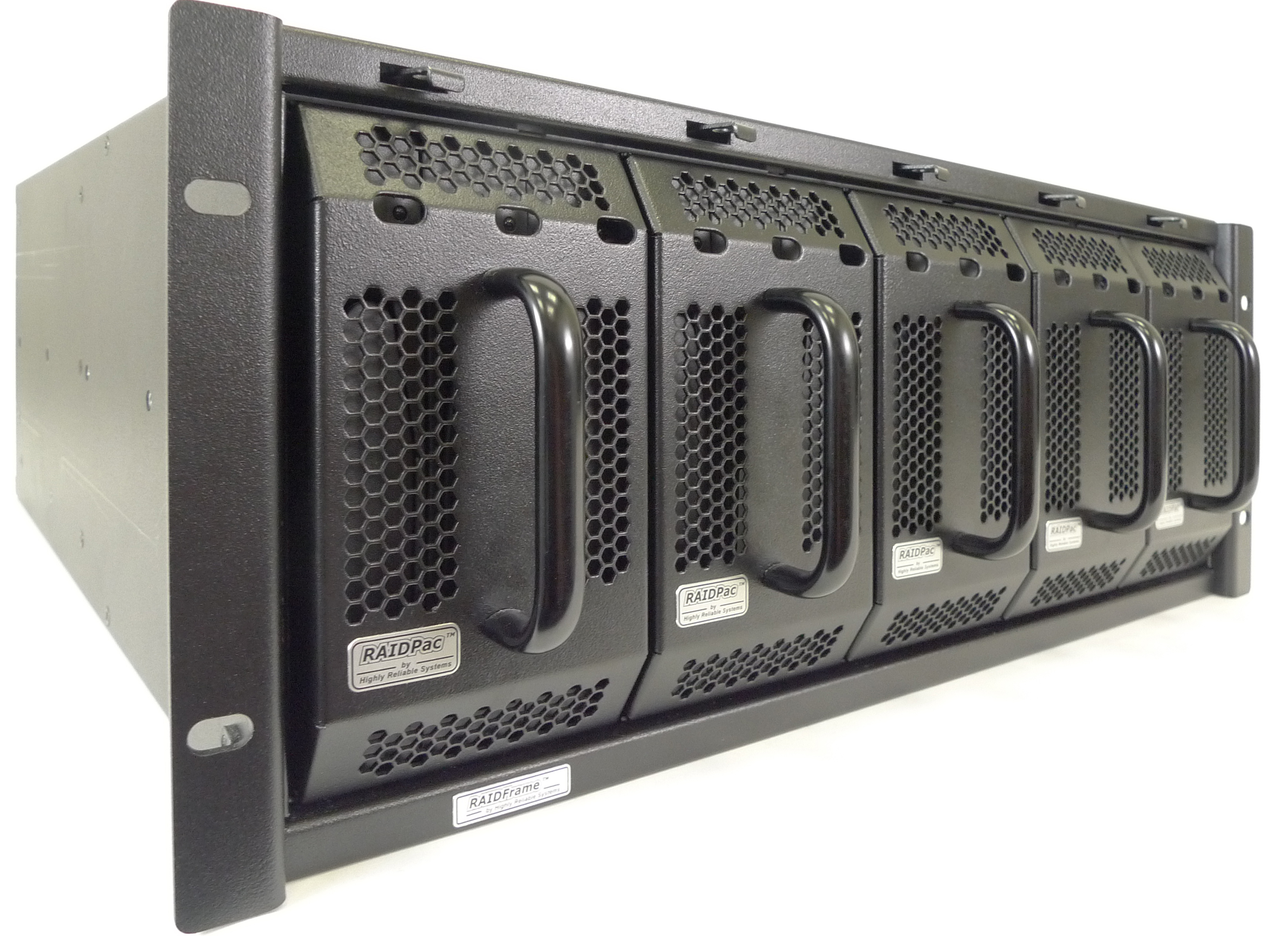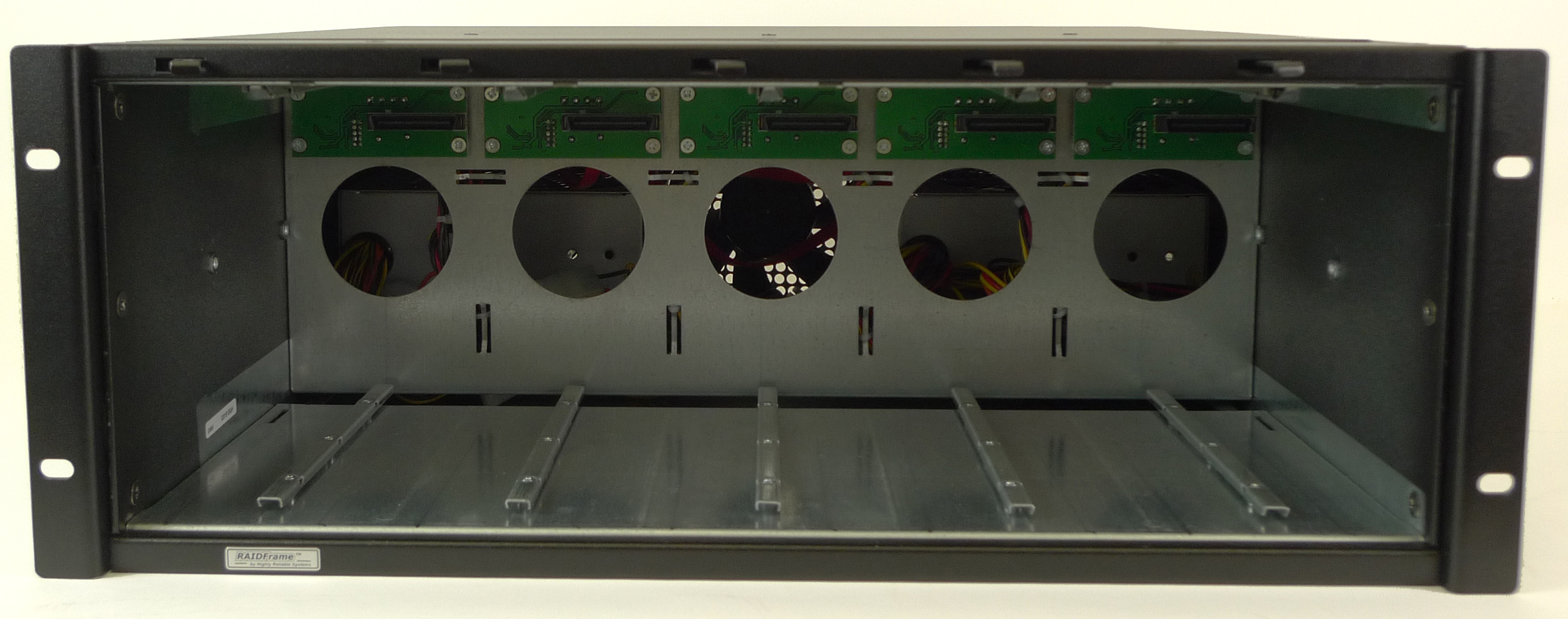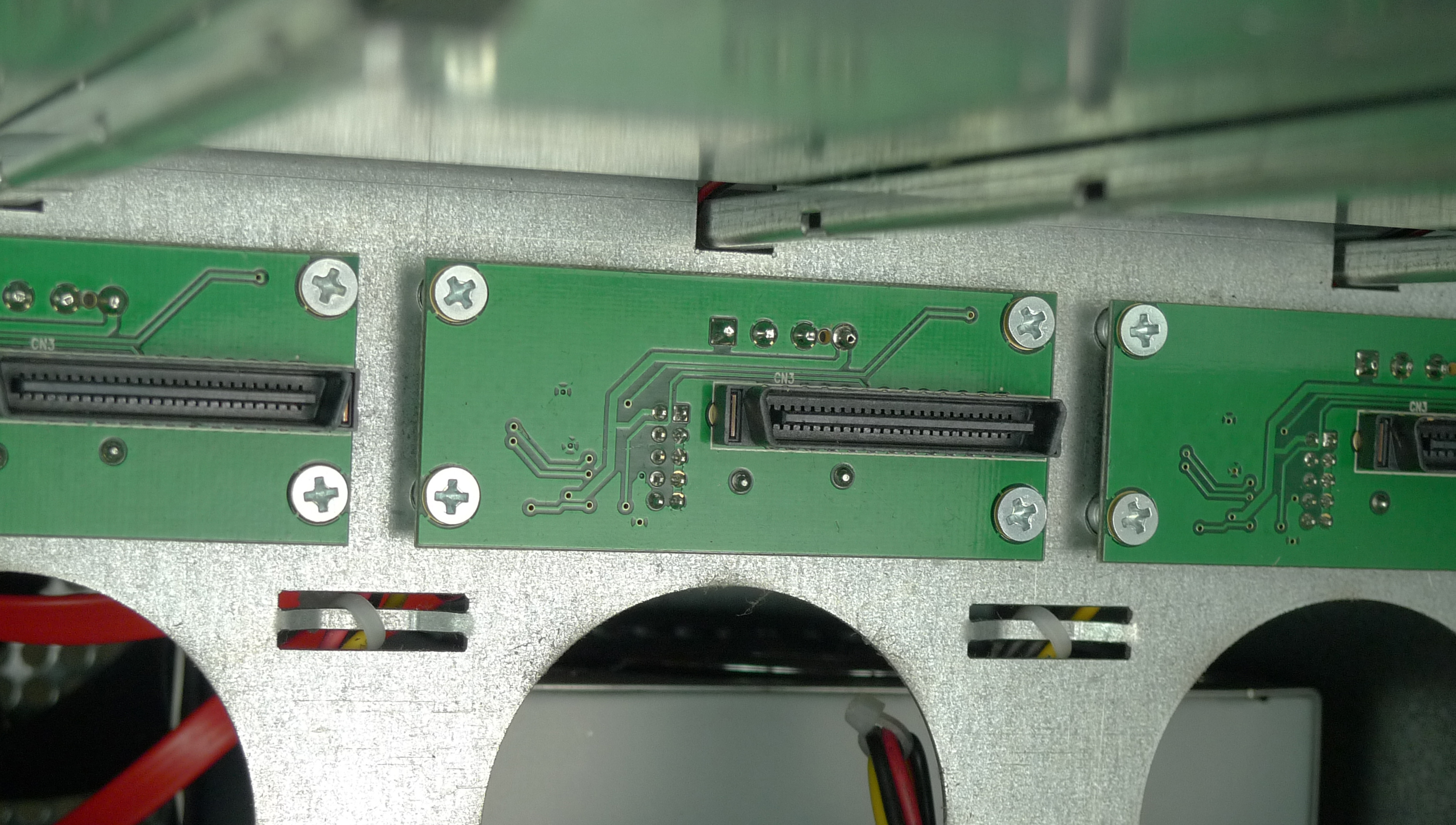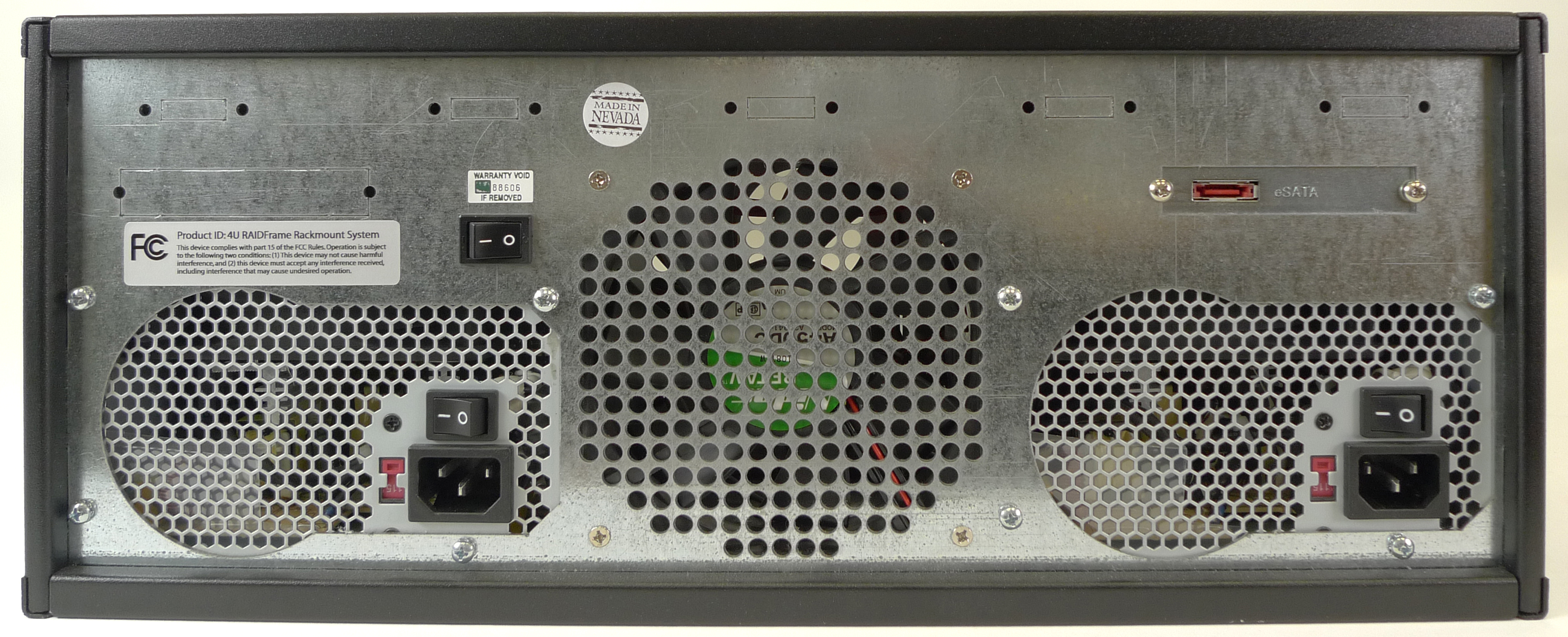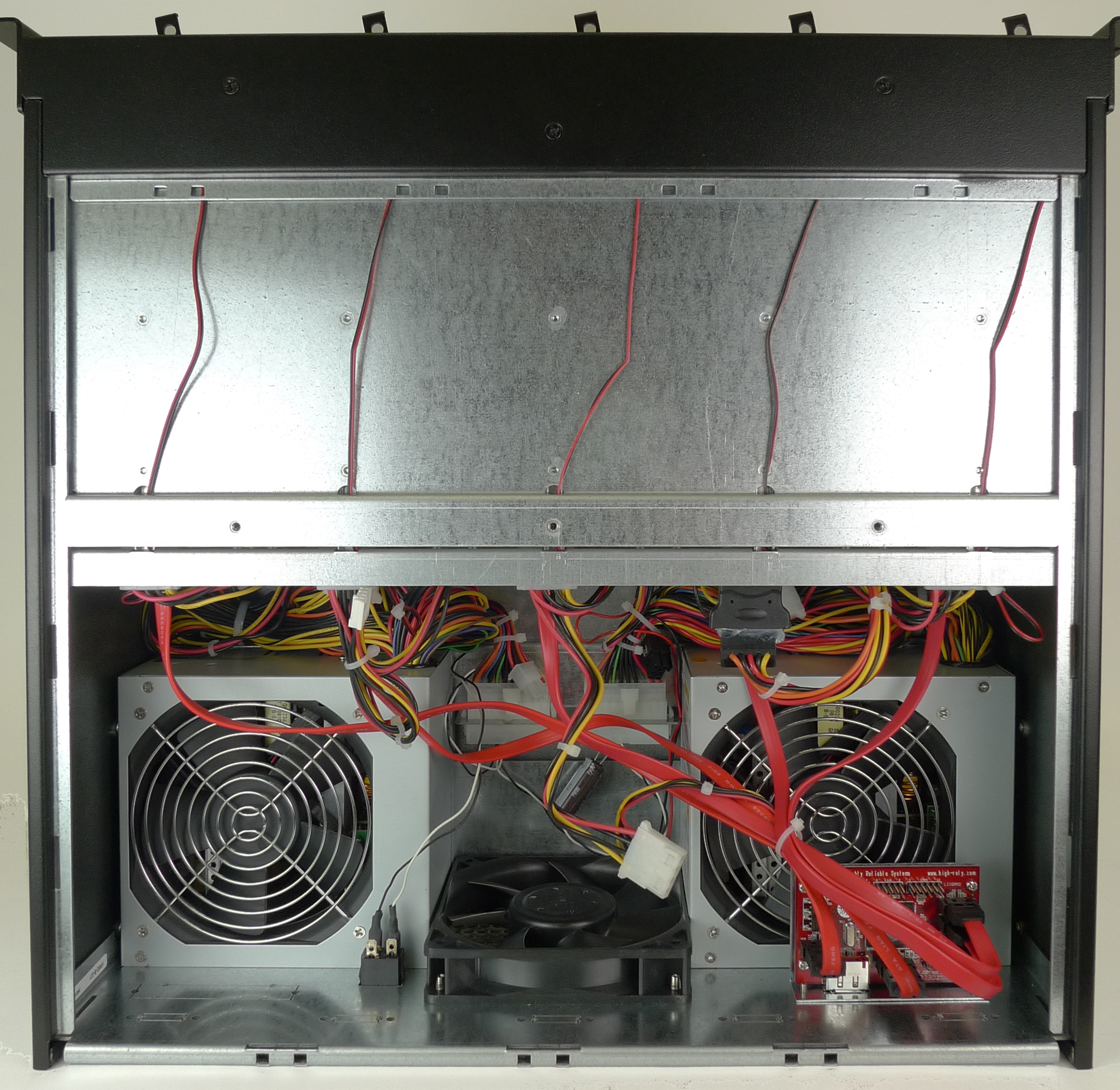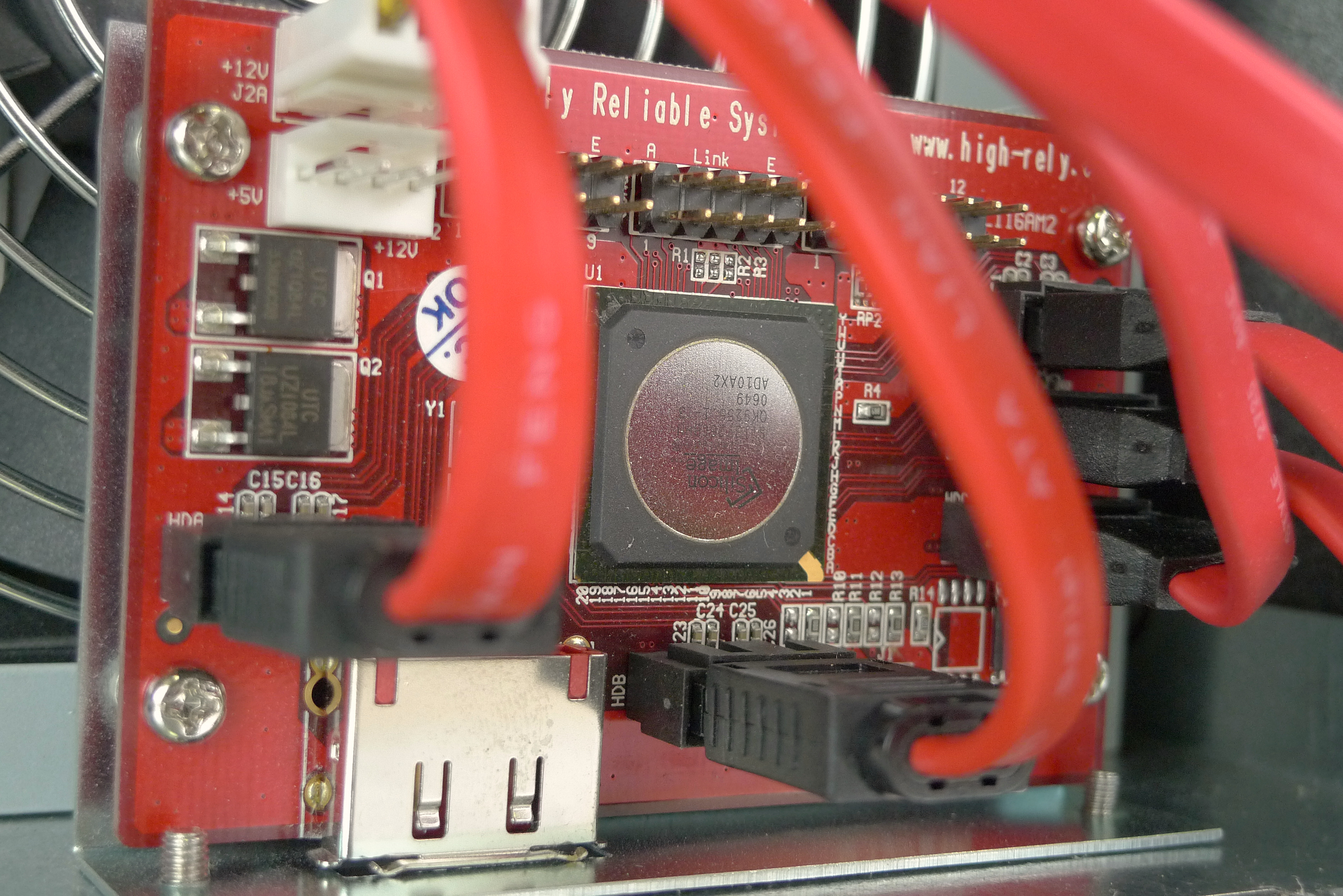Hi-Rely RAIDFrame: External Disk-To-Disk Backup Via eSATA
RAIDFrame Chassis
The core component of the RAIDFrame backup system is the RAIDFrame chassis. Designed to be rack mountable, the chassis is 3U in height and 17.5” inches deep. Fully configured, the all-metal frame provides the nice, sturdy shell that houses five RAID-enabled disk drive cartridges called RAIDPacs. The barebone-like design of the RAIDFrame doesn’t provide much by way of alarms or lights on the chassis itself. Instead, all the alerting lights and sounds are built into the individual RAIDPacs.
Across the front of the RAIDFrame chassis are five 3-3/8 inch-wide bays used to mount the inserted RAIDPacs. The remaining real estate around the front bezel is sparse. There isn’t even enough space to add built-in handles into the front of the body for pulling the chassis in and out of a rack cabinet.
On the back panel, you have two partially-exposed ATX power supplies; each with its own power plug receptacle and rocker switch, a grill for the centrally-placed 4-3/4 inch exhaust fan, and a single eSATA port. There’s also a master switch for both power supplies that will keep the chassis powered on as long as both power supply rockers are left in the "on" position.
Internally, the RAIDFrame can be split into two zones. Fully or partially populated, the front half of the chassis is the heavier end of the device. Each RAIDPac slides into a bay, connected through a small circuit board that provides power and I/O to the disks inside the RAIDPac modules.
The back half of the RAIDFrame chassis holds the two power supplies, SATA and power cables, and the port multiplier board that splits the single eSATA input into separate five channels; each going to a different RAIDPac.
The great thing about the components used in the RAIDFrame is that a lot of the parts are non-proprietary and easily maintained. Highly-Reliable’s goal is to provide its customers with a product that uses components that are easily replaced. For example, powering the RAIDFrame and the RAIDPacs are two SPI ATX12V 2.2 power supplies running at 450W each. Per Highly Reliable, you can swap out these power modules with compatible power supplies as long as the minimum wattage is 350W.
Having two power supplies, you may think that the RAIDFrame is redundant, but it’s not. Since the RAIDPacs run independently from each other, there is no actual requirement to keep them all running at the same time. As configured, the power supply on the left provides power to the three RAIDPacs on the left side of the RAIDFrame (and also the exhaust fan). The power supply on the right side powers the remaining two RAIDPacs on the right. Despite its twin PSUs and cooling fan, the unit is not that noisy.
Get Tom's Hardware's best news and in-depth reviews, straight to your inbox.
Overall, the design of the chassis is pretty straightforward. The one RAIDFrame part that may be hardest to replace is the port multiplier. I was told by representatives at Highly Reliable that getting an additional port multiplier installed into a custom configuration requires shipping the RAIDFrame to the vendor’s office in Reno, Nevada. Though, its easily mountable via two pre-allocated spots inside the case, Highly Reliable would rather make the change itself. That being the case, you’re better off ordering the configuration you want from the get-got. The demo configuration we were shipped is not a required setup, and can be easily changed around to suit different purposes. The decision to use non-proprietary power supplies and connections gives the technician the added flexibility of configuring which power supply powers a given RAIDPac or set of RAIDPacs. You just need to compensate for the length of the power leads coming out of the supply and get them to reach the RAIDPac interfaces located across the chassis’ center divider.
As mentioned above, the single eSATA connection going into the RAIDFrame is split into five different channels at the port multiplier board. From the board, five eSATA channels plug into each of five midplane boards used to provide power and I/O to the RAIDPac cartridges.
-
yyrkoon Perhaps I missed something, But I am curious as to how they got 3 drives per port on the port multiplier. I am familiar with port multipliers, but not the technology they use here apparently.Reply
Also, on a side note, I think this device would be more useful if it allowed you to run RAID 10, but with two out ports. Perhaps even multilane would be in order in this case ? -
yyrkoon Let me clarify what I said above. I feel the device would be "better" if they allowed it to be configured to run RAID 10 using two RAIDPacks.Reply -
jeffunit Nice hardware, but a bit spendy. My software based raid 5 array has higher performance over gigabit ethernet, uses commodity parts, and is much cheaper. I am sure my array costs well under $1000 with 8 750gb drives. Since I am using supermicro hot swap sata drive cages, all I have to do is press a button and the drive comes out. 4 screws, and the drive is removed. Takes well under 5 minutes to remove a drive and put in a new one, and it just takes a philips screwdriver.Reply
And why are there two 450w power supplies? Even if the box is full, that is 30 watts per drive, which is a crazy amount of power. If they stagger the drive spin up, they would never need more than 225w tops.
-
climber This should be a 6Gb/s SATA 3.0 design with port multipliers. If you wanted to back up serious amounts of data to this thing you'd never finish, it would always be in backup mode.Reply -
so if one of the three drives should fail inside a RAIDpac, you have to eject the whole RAIDpac to replace that drive?Reply
That sets the RAID offline ... a RAID 5 should be allow hotswapping a failed disk.
And two PSU but not redundant ? ... doens't seem very HIGH RELIABLE -
thehighrelyguy Although some of these points were mentioned in the article, not being on the front page, these important features may have been missed by a few readers and may answer some of your questions.Reply
1. Each RAID pack has an integrated RAID 5 / RAID 0 controller. This means the RAIDPACs can operate completely standalone without the addition of any special controllers or driver software. Thus, left with nothing but a RAIDPac, you could connect it via eSATA to your motherboard and restore the data.
2. The RAIDpacs use standard SATA hard drives. At present, 2.0TB drives are available making the available capacities 4TB in RAID 5 and 6TB in RAID 0 per RAID pack.
3. There is also a 1 bay RAIDFrame available which can use RAIDPacs interchangeably with the 5 Bay if necessary. The one bay has both ESATA and USB connections for portability and ease of connection. The one bay is substantially cheaper than the 5 bay.
4. The dual ATX power supplies were chosen over specialty redundant power supplies because they are the most widely available power supply in the world making field service for this unit in the dead of the night, practical. The 1 bay has this same feature. By using two instead of one, if a power supply dies, you're not dead, the unit is still usable although some bays may not function.
-
thehighrelyguy yyrkoonPerhaps I missed something, But I am curious as to how they got 3 drives per port on the port multiplier. The RAIDFrame is not a single RAID system. The RAIDFrame 5 bay is 5 RAID systems. Each hot swappable RAIDPac is a volume. Port multipliers allow up to 5 volumes (drives) to one SATA channel. Hence one SATA channel, 5 RAIDPacs.Reply
